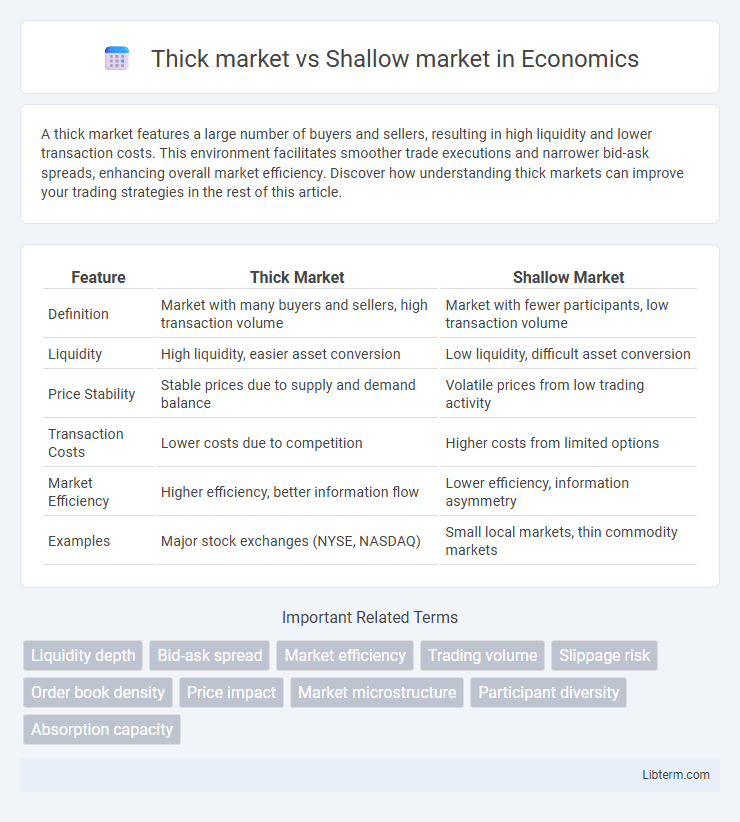A thick market features a large number of buyers and sellers, resulting in high liquidity and lower transaction costs. This environment facilitates smoother trade executions and narrower bid-ask spreads, enhancing overall market efficiency. Discover how understanding thick markets can improve your trading strategies in the rest of this article.
Table of Comparison
| Feature | Thick Market | Shallow Market |
|---|---|---|
| Definition | Market with many buyers and sellers, high transaction volume | Market with fewer participants, low transaction volume |
| Liquidity | High liquidity, easier asset conversion | Low liquidity, difficult asset conversion |
| Price Stability | Stable prices due to supply and demand balance | Volatile prices from low trading activity |
| Transaction Costs | Lower costs due to competition | Higher costs from limited options |
| Market Efficiency | Higher efficiency, better information flow | Lower efficiency, information asymmetry |
| Examples | Major stock exchanges (NYSE, NASDAQ) | Small local markets, thin commodity markets |
Understanding Thick Markets: Definition and Features
Thick markets are characterized by a high volume of buyers and sellers, resulting in greater liquidity and tighter bid-ask spreads. These markets facilitate efficient price discovery due to increased trading activity and reduced transaction costs. Features of thick markets include deep order books, frequent trades, and narrower spreads, which collectively enhance market stability and investor confidence.
What Are Shallow Markets? Key Characteristics
Shallow markets are financial markets characterized by low trading volume and limited liquidity, leading to larger price fluctuations and higher volatility. Key characteristics include fewer market participants, wide bid-ask spreads, and susceptibility to price manipulation due to insufficient buy and sell orders. These market conditions often result in inefficient price discovery and increased transaction costs.
Liquidity Differences: Thick vs Shallow Markets
Thick markets exhibit high liquidity, characterized by large trading volumes and tight bid-ask spreads, enabling smooth transaction execution with minimal price impact. Shallow markets suffer from low liquidity, marked by fewer participants and wider spreads, which leads to increased price volatility and higher transaction costs. The disparity in liquidity significantly affects market efficiency and price stability in thick versus shallow markets.
Price Stability: Impact of Market Depth
Thick markets exhibit high liquidity with numerous buy and sell orders, resulting in greater price stability due to reduced price volatility from large trades. Shallow markets have limited participants and low order volume, causing prices to fluctuate sharply and increasing susceptibility to manipulation. Market depth directly influences transaction costs and risk, making thick markets more favorable for consistent price discovery.
Participant Behavior in Thick and Shallow Markets
Thick markets exhibit high liquidity with numerous buyers and sellers actively engaging, resulting in tighter bid-ask spreads and more efficient price discovery. In contrast, shallow markets have fewer participants, causing wider spreads and increased price volatility due to limited competition and lower transaction volumes. Participant behavior in thick markets tends to be more strategic and informed, while in shallow markets, traders may face higher risk and uncertainty influencing cautious or opportunistic actions.
Transaction Costs: Comparing Market Types
Thick markets, characterized by high trading volumes and numerous participants, typically exhibit lower transaction costs due to increased liquidity and narrower bid-ask spreads. In contrast, shallow markets with fewer traders and lower trading activity often face higher transaction costs, including wider spreads and increased price impact from individual trades. These cost differences significantly influence trading strategies and market efficiency across various financial instruments.
Risks Associated with Shallow Markets
Shallow markets, characterized by low trading volume and limited liquidity, expose investors to higher risks such as significant price volatility and wider bid-ask spreads. These conditions increase the likelihood of market manipulation and slippage, where large orders can disproportionately impact asset prices. In contrast to thick markets, shallow markets often hinder efficient price discovery, elevating uncertainty and potential losses for traders.
Trading Strategies for Thick and Shallow Markets
Thick markets, characterized by high liquidity and numerous buyers and sellers, enable trading strategies such as scalping and high-frequency trading that rely on quick order execution and tight spreads. Shallow markets, with lower liquidity and wider spreads, require strategies like limit orders and position trading to manage price impact and reduce slippage. Understanding market depth and volume is crucial for selecting the appropriate approach and optimizing trade execution in varying market conditions.
Real-world Examples of Thick and Shallow Markets
Thick markets like the New York Stock Exchange offer high liquidity and narrow bid-ask spreads due to a large number of buyers and sellers, facilitating efficient price discovery. Shallow markets, such as niche collectibles or some emerging cryptocurrencies, suffer from low trading volumes and wide spreads, leading to higher volatility and difficulty in executing large trades. Real-world examples highlight how thick markets support stable economic activity, while shallow markets pose risks for investors due to limited participation.
Choosing the Right Market: Factors to Consider
Choosing the right market involves evaluating liquidity, trading volume, and bid-ask spread to determine whether a thick market or shallow market suits your investment strategy. Thick markets offer high liquidity and tighter spreads, reducing transaction costs and enhancing price stability, while shallow markets may present higher volatility and wider spreads due to lower trading activity. Assessing market depth, asset volatility, and your risk tolerance helps optimize trade execution and portfolio performance.
Thick market Infographic

 libterm.com
libterm.com